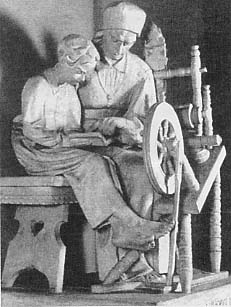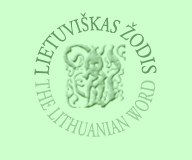-
 Press
ban, imposed by the Russian authorities on Lithuanian publications
from 1864-1904. It forbade the publication or import from abroad of
Lithuanian books and periodicals printed in the Latin alphabet. Only
Lithuanian books using the Cyrillic script were permitted. Lasting 40
years, the ban provoked a tremendous national response culminating in
the successful knygnesiai movement.
Press
ban, imposed by the Russian authorities on Lithuanian publications
from 1864-1904. It forbade the publication or import from abroad of
Lithuanian books and periodicals printed in the Latin alphabet. Only
Lithuanian books using the Cyrillic script were permitted. Lasting 40
years, the ban provoked a tremendous national response culminating in
the successful knygnesiai movement.
-
- Origins of the Ban
- The idea of adapting the Cyrillic
alphabet to the Lithuanian written language was first proposed by
linguist Andrew Ugenski, professor of Kazan' University, in a letter
to Bishop Valancius. This idea was further elaborated by the well
known Pan Slavist Alexander Hilferding in his book Litva i Zhmudz' (Lithuania
and Samogitia, 1863). He proposed that Lithuanian replace Polish as
the language of instruction in schools and that the Cyrillic alphabet
be used in place of the Polonized Latin script then current in written
Lithuanian. Hilferding and other Pan-Slavists believed that if the
Lithuanian peasantry could be drawn away from the Polonized nobility
and the Roman Catholic Church, it would naturally gravitate toward
Russia as its “natural” base (nachalo). The Cyrillic reform
was thus intended to aid the process of Lithuania's Russification. The
Polish Lithuanian insurrection of 1863 convinced many Russian military
men and educators, particularly M. N. Muraviev and I. P. Kornilov,
that Polish cultural and political influence was the main obstacle to
successful Russian domination in Lithuania.
- Jonas Juskevicius-Juska, a linguist and
a high school teacher from St. Petersburg, was the first to experiment
actively with the adaptation of Cyrillic characters to written
Lithuanian. In February, 1864, he met with I. P. Kornilov, the
chief educational officer in Lithuania. Kornilov urged Juska to
rewrite some Lithuanian texts in the Cyrillic alphabet. These texts
were then shown to Governor General Muraviev, who reportedly was
favorably impressed with them. Juska, however, did not continue this
work, so Kornilov next turned to Stanislaw Mikucki, a Warsaw librarian
and close friend of Hilferding. With Mikucki's help Kornilov organized
a commission to prepare Cyrillic Lithuanian books for publication by
the government. In addition to Mikucki, the commission included
Antanas Petkevic'ius, a convert to Orthodoxy, and Laurynas Ivinskis, a
well known Lithuanian publisher. Ivinskis, sensing popular resistance
to the government's Cyrillic project, later withdrew from the
commission.
- The first Lithuanian book in Cyrillic, Abecele
zemaitiskai-lietuviska (The Lithuanian Samogitian Primer) was
published in the summer of 1864. This primer was intended for use in
the new government rural schools narodnye shkoly) which
replaced the Catholic parish school system. The Abecele was
followed by catechisms, gospels and kantickos (popular
hymnals). A total of about 50 Cyrillic Lithuanian books, mainly of
religious character, were published b the Russian government during
the press ban period. Bishop Valancius gave his reluctant imprimatur
to the first Cyrillic editions of religious books, but later came
out in opposition to the press ban.
- Enactment and Enforcement. In addition
to publishing Lithuanian books in the Cyrillic script, the Russian
government began an active campaign against the Lithuanian press in
the Latin alphabet (frequently referred to as the “Latin-Polish”
alphabet). In the summer of 1864 Muraviev issued an administrative
order forbidding the publication of Lithuanian textbooks in the Latin
alphabet. The prohibition was formalized into a comprehensive press
ban on all Latin Lithuanian publications on Sept. 6, 1865 by C. P. von
Kaufman, Muraviev's successor as governor-general. He also issued a
circular to the governors of neighboring gubernias, asking them to
cooperate in the ban on Lithuanian books. The press ban was confirmed
by Russia's Minister of the Interior P. A. Valuiev on September 23,
1865, and extended to the whole Russian Empire. The government's harsh
attitude towards the Lithuanian press expressed itself in the activity
of the Commission for the Examination of Samogitian Lithuanian Books (Komissia
dlia rassmotrenia zhmudsko litovskikh knig). This commission,
established in August, 1865, was composed of members of the Russian
military and civil bureaucracy in Lithuania. The commission concluded
that the Lithuanian press, mostly religious at this time, was
allegedly subversive, “filled with anti-Russian propaganda … and
agitation against the dominant religion of the state Orthodoxy.”
- During the period of the ban, Russian
authorities steadily escalated the war on the illegal Lithuanian
press. The first two decades were relatively mild in terms of police
activity. Russian gendarmes carried out only occasional searches and
book raids in the countryside. Persons who were found possessing the
illegal literature were usually (though not always) dealt with on an
administrative rather than judicial level and turned over to local
police and judges (mirovye posredniki). At first, punishments
and fines were relatively light. The vast majority of those arrested
were ordinary peasants. But during the last two decades of the ban
police surveillance and repression intensified considerably. This was
due mainly to the proliferation of political and nationalist
literature, such as the periodicals Ausra (The Dawn) and Varpas
(The Bell). Russian police began to concentrate their attention on the
educated segments of the peasantry. In 1897 police succeeded in
breaking up the Lithuanian secret society Sietynas (Network);
38 people, mainly young members of the intelligentsia, were arrested.
During 1896 and 1897 Russian gendarmes launched an unprecedented wave
of searches and arrests throughout Suvalkija (Southern Lithuania) in
an effort to enforce the press ban. However, such measures had little
effect on the distribution of the illegal publications and by the turn
of the century, more books than ever were spreading through the
Lithuanian countryside.
- hand in hand with repressing the
Latin-Lithuanian press, the Russian authorities tried to include
Lithuanians, especially the peasantry, to accept the Cyrillic books
published by the government. This attempt failed completely.
Subsequently Vaclovas Birziska conducted a study as to the fate of the
Cyrillic books by ehamining individual school budgets in Kaunas
province (gubernia) for the years 1874 to 1880. In the school at
Slabada, for example, not one book had been sold out of 187 in stock.
The Rumsiskes school, which received 58 Cyrillic books from provincial
authorities, had not sold provincial authorities, had not sold a
single one by 1878. In the 14 schools on which data were available, a
total of only 154 Cyrillic Lithuanian books were listed as sold during
the six year period in question. Birziska suspects that a good number
of these were purchased by embarrassed local teachers who feared
government displeasure at their failure to promote Cyrillic books.
Some peasants who were pressured into buying the government books
simply burned them at home. Prince P. D. Sviatopolk-Mirsky, governor
general of Vilnius, reported in 1903 that even when distributed free,
Lithuanian books in Cyrillic failed to find acceptance among the
people.
-
Text
from the ENCYCLOPEDIA LITUANICA I-VI. Boston, 1970-1978

